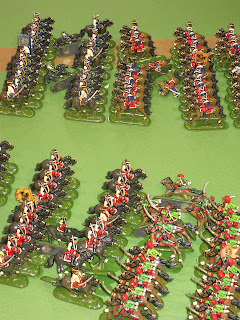Using hexes for movement has the advantage of removing any fiddly measurements to determine what moves our table-top units can, or cannot, perform on the table-top. Converting wargames rules to use hexes does require a number of choices to be made and when it comes to unit facing I for one am firmly in the ‘face the vertex’ camp as shown in the diagram below. Facing the vertex as opposed to the ‘flat’ works well for defining frontal arcs, flank and rear zones but means forward movement follows a zig-zag course with units staggering forward like drunkards.
One of the rule-sets I have re-jigged to work on hexes is DBM using 15mm figures on 4cm wide bases, which gives two elements side by side in the 10cm-wide Hexon tiles that I use. One day while wrestling with zig-zagging units my opponent, Martin, pointed out that as elements only occupy half a hex why not let them move straight ahead, elements in the right-hand side of the hex advancing into the left-hand side of the hex ahead (see diagram below). The simple elegance of this solution was immediately apparent and why I had been unable to see it before escapes me – sometimes it can be hard to see beyond customary practice.
I think this system works well but clearly, it’s dependent on relative unit/element width and hex size. However, 4cm is a fairly standard 15mm base width and Hexon is one of the more common systems (I have no connection with the company that makes it). I doubt this has not been thought of before but I haven’t seen it being used elsewhere so thought I’d share it.

























